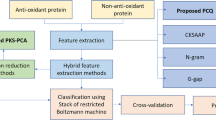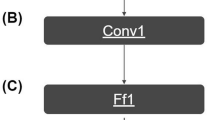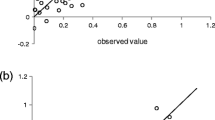Abstract
Antioxidant proteins are a kind of molecules that can terminate cellular and DNA damages caused by free radical intermediates. The use of antioxidant proteins for prevention of diseases has been intensively studied in recent years. Thus, accurate identification of antioxidant proteins is essential for understanding their roles in pharmacology. In this study, a support vector machine-based predictor called AodPred was developed for identifying antioxidant proteins. In this predictor, the sequence was formulated by using the optimal 3-gap dipeptides obtained by using feature selection method. It was observed by jackknife cross-validation test that AodPred can achieve an overall accuracy of 74.79 % in identifying antioxidant proteins. As a user-friendly tool, AodPred is freely accessible at http://lin.uestc.edu.cn/server/AntioxiPred. To maximize the convenience of the vast majority of experimental scientists, a step-by-step guide is provided on how to use the web server to obtain the desired results.


Similar content being viewed by others
References
Lobo V, Patil A, Phatak A, Chandra N (2010) Free radicals, antioxidants and functional foods: impact on human health. Pharmacogn Rev 4:118–126
Barbusinski K (2009) Fenton reaction-controversy concerning the chemistry. Ecol Chem Eng S 16:347–358
Shah AM, Channon KM (2004) Free radicals and redox signalling in cardiovascular disease. Heart 90:486–487
Pham-Huy LA, He H, Pham-Huy C (2008) Free radicals, antioxidants in disease and health. Int J Biomed Sci 4:89–96
Fernandez-Blanco E, Aguiar-Pulido V, Munteanu CR, Dorado J (2013) Random forest classification based on star graph topological indices for antioxidant proteins. J Theor Biol 317:331–337
Dreher D, Junod AF (1996) Role of oxygen free radicals in cancer development. Eur J Cancer 32A:30–38
Maxwell SR (2000) Coronary artery disease-free radical damage, antioxidant protection and the role of homocysteine. Basic Res Cardiol 95:65–71
Bailey DM, Evans KA, James PE, McEneny J, Young IS, Fall L, Gutowski M, Kewley E, McCord JM, Moller K, Ainslie PN (2009) Altered free radical metabolism in acute mountain sickness: implications for dynamic cerebral autoregulation and blood-brain barrier function. J Physiol 587:73–85
Mecocci P, Polidori MC, Troiano L, Cherubini A, Cecchetti R, Pini G, Straatman M, Monti D, Stahl W, Sies H, Franceschi C, Senin U (2000) Plasma antioxidants and longevity: a study on healthy centenarians. Free Radic Biol Med 28:1243–1248
Chou KC (2011) Some remarks on protein attribute prediction and pseudo amino acid composition. J Theor Biol 273:236–247
Feng PM, Lin H, Chen W (2013) Identification of antioxidants from sequence information using naive Bayes. Comput Math Methods Med 2013:567529
Fu L, Niu B, Zhu Z, Wu S, Li W (2012) CD-HIT: accelerated for clustering the next-generation sequencing data. Bioinformatics 28:3150–3152
Ding C, Yuan LF, Guo SH, Lin H, Chen W (2012) Identification of mycobacterial membrane proteins and their types using over-represented tripeptide compositions. J Proteom 77:321–328
Chen W, Feng PM, Lin H, Chou KC (2013) iRSpot-PseDNC: identify recombination spots with pseudo dinucleotide composition. Nucleic Acids Res 41:e68
Chen W, Feng PM, Lin H (2012) Prediction of replication origins by calculating DNA structural properties. FEBS Lett 586:934–938
Liu B, Wang X, Lin L, Dong Q, Wang X (2009) Exploiting three kinds of interface propensities to identify protein binding sites. Comput Biol Chem 33:303–311
Chou KC (2001) Prediction of protein cellular attributes using pseudo-amino acid composition. Proteins 43:246–255
Ding H, Guo SH, Deng EZ, Yuan LF, Guo FB, Huang J, Rao NN, Chen W, Lin H (2013) Prediction of Golgi-resident protein types by using feature selection technique. Chemometr Intell Lab Syst 124:9–13
Lin H, Chen W, Ding H (2013) AcalPred: a sequence-based tool for discriminating between acidic and alkaline enzymes. PLoS ONE 8:e75726
Feng PM, Ding H, Chen W, Lin H (2013) Naive Bayes classifier with feature selection to identify phage virion proteins. Comput Math Methods Med 2013:530696
Feng PM, Chen W, Lin H, Chou KC (2013) iHSP-PseRAAAC: Identifying the heat shock protein families using pseudo reduced amino acid alphabet composition. Anal Biochem 442:118–125
Guo SH, Deng EZ, Xu LQ, Ding H, Lin H, Chen W, Chou KC (2014) iNuc-PseKNC: a sequence based predictor for predicting nucleosome positioning in genomes with pseudo k-tuple nucleotide composition. Bioinformatics 30:1522–1529
Lin H, Ding H (2011) Predicting ion channels and their types by the dipeptide mode of pseudo amino acid composition. J Theor Biol 269:64–69
Frank E, Hall M, Trigg L, Holmes G, Witten IH (2004) Data mining in bioinformatics using weka. Bioinformatics 20:2479–2481
Acknowledgments
This work was supported by National Nature Scientific Foundation of China (Nos. 61100092 and 61202256), Nature Scientific Foundation of Hebei Province (No. C2013209105), and Foundation of Science and Technology Department of Hebei Province (No. 132777133).
Author information
Authors and Affiliations
Corresponding authors
Ethics declarations
Conflict of interest
The authors have declared that no competing interests exist.
Rights and permissions
About this article
Cite this article
Feng, P., Chen, W. & Lin, H. Identifying Antioxidant Proteins by Using Optimal Dipeptide Compositions. Interdiscip Sci Comput Life Sci 8, 186–191 (2016). https://doi.org/10.1007/s12539-015-0124-9
Received:
Revised:
Accepted:
Published:
Issue Date:
DOI: https://doi.org/10.1007/s12539-015-0124-9




